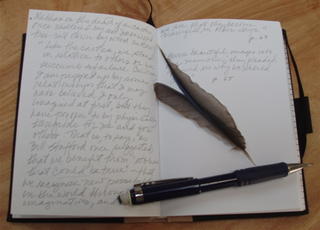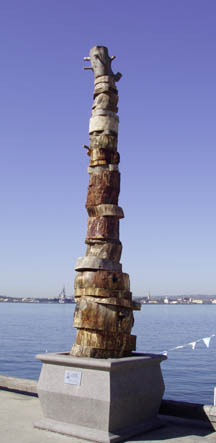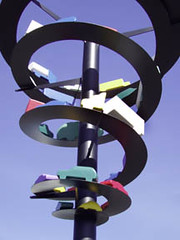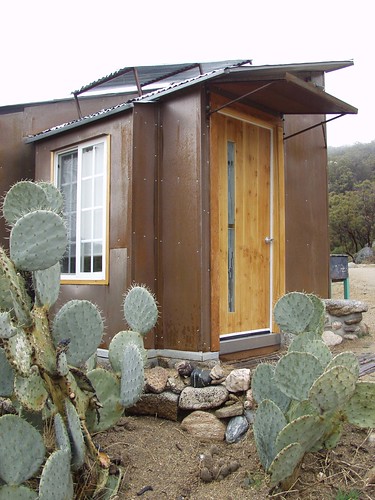
On a blue-black evening in August 2005 I attended a candlelight vigil in support of Cindy Sheehan, the mother whose son’s death in Iraq spurred her to leave her home in Vacaville, California and set up her lawn chair in the punishing heat alongside the road leading to George W. Bush’s ranch in Crawford, Texas.
As I stood in a circle of strangers in the middle of Spreckles Park, my candle struggling against the cool night breeze of this California coastal community, I thought of the searing heat of Texas in summer, and the all consuming heat of Bagdhad. A week before I had spoken long distance with my surrogate son, now serving in Iraq with the US Army. He said the heat continued to bear down on them without relief; you could not get used to it, you could not escape it.
It seems incomprehensible to talk to him on the telephone as if he were just down the road in his apartment, checking in with me on a Sunday afternoon. When he calls I talk about working in the yard, going to the ball game, planning his brother’s wedding, taking a drive in the car. We never speak about the war or what his days are like. The conversations about the simple routine of home are part of the unspoken bargain we’ve struck that holds the stalking presence of death at bay.
In the summer of 2005 I, like every other media drenched American, had come to know the compelling image of Cindy Sheehan in her grief-fueled activism. She was the reason why I was signing petitions and attending vigils. Hers was the simplest of gestures; to sit patiently to wait for a president to answer questions about a war that millions of Americans did not understand or support. It struck the imagination of Americans like a hammer, and prodded complacent people to action. And in the lagging days of summer it was a great story for the media; something to keep that frighteningly voracious machine fed. To be sure, the same media that adored her image would also crank the machine into overdrive to tear her image apart, and ultimately (predictably) she would fall off the radar screen. But that would come later. For the moment, I was seeing her everywhere.
A few days after the vigil, I unwrapped the Kollwitz self-portrait that now graces my living room wall. It is a grieving profile done in 1927, five years before the Nazis would strip her of her position as professor of art at the Prussian Academy, and four years before she would complete her 17 year project, “The Parents / Die Eltern,” a monument to her youngest son Peter who died in the first week of World War I. And in the most tragic of bookends, in 13 years she would lose her grandson, also named Peter, in the Second World War.

1927 was then, in retrospect, an interim year; a year in which the accumulating weight of loss might have shifted slightly, giving the false sense of relief of a wound finally healing. The portrait is sculptural, as if the carving of her monumental figures, “Die Eltern,” had impressed itself in the tissue and muscle of her hands, transforming the drawing of her own face into the same exercise of carving, this time with the litho crayon. The artist presents herself in profile with a minimum of strokes of the crayon and the portrait is unfinished in everything except the eyes and mouth, which manage to carry a complexity of spirit and emotion.
Unlike Kathe Kollewitz, in that summer of 2005 Cindy Sheehan did not control the making or reproduction of her physical image. She was, instead, the object to which photographers flocked, filtering their own aesthetic, political, or news vision through her reflection in the lenses of their cameras. And while it can be argued that in a media loaded culture we, as media savvy consumers, are all consciously shaping and reshaping our image, there are moments in which the authentic self breaks through the media lens; moments in which there is no playing to the camera.
 I found one such image on the internet, a simple full face head shot of Cindy Sheehan against a backdrop sky. Only a small piece of a structure (a shed? a barn?) is visible in the right hand corner. I was struck by its raw simplicity, the lack of the usual journalistic artifice, and its connection to the portrait in my living room.
I found one such image on the internet, a simple full face head shot of Cindy Sheehan against a backdrop sky. Only a small piece of a structure (a shed? a barn?) is visible in the right hand corner. I was struck by its raw simplicity, the lack of the usual journalistic artifice, and its connection to the portrait in my living room.I am looking at them both as I write this, and what strikes me most is the description of pain in the faces of these mothers separated by time, history, and culture. A mother reflecting on the possible death of a child (and quick, erase the thought so as not to bring about the unthinkable!) might imagine herself consumed by a kind of careening, flailing, spinning grief, interrupted by too-short periods of unconsciousness. So it is deeply dread-full to view these portraits with their unscreamed screaming, and to feel the weight, the fatigue, of pain that cuts off breathing but won’t allow death.
With Sheehan, as with Kollwitz, it is the eyes and mouth that convey the enormity of suffering. There is a dimension to the Sheehan expression of pain—the eyes squinting as if in a too bright sunshine—that gives away the effort of managing an unremitting physical trauma. The mouth is slightly open like the tiny tear that leaks an almost imperceptible stream of grief. The gaze is direct and completely without the polite conventions that we use in public to shield us from having to care about one another. It is a hard image to look at without turning away in embarrassment; we are seeing too much.
In Kollwitz’ self-portrait in profile, the mouth is closed, and suggests the great weight carried within. She seems carved in stone, but with suggestions of great humanity in the lines drawn around the mouth and the eyes. The tragedies of her losses are evident in her carved countenance, but her human qualities are given away in the lightness and even tenderness of a few strokes of her crayon. What puzzles me most is the direction of her gaze. At times she seems straightforward in looking ahead, at others I think I see her casting a momentary glance to her right, as if her attention had been momentarily captured by something or someone passing by the window. I wonder what might have diverted her from her unceasing sadness.
All grief is cold, and I am reminded of this in the two portraits. Perhaps it is the frozen quality that life takes on when human grief takes hold. One lives in an airless bubble where life moves past and around like a stone in a river.
With the war in Iraq now a permanent part of our present and future, these portraits help me break through the inundation of talk and images that makes even the most tragic and destructive events seem banal.







